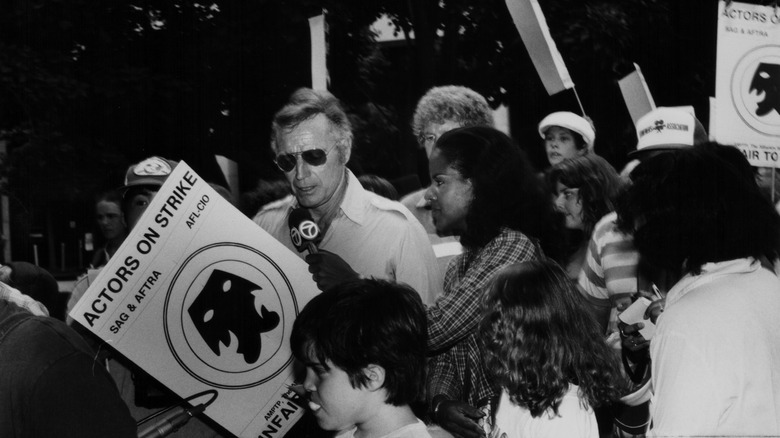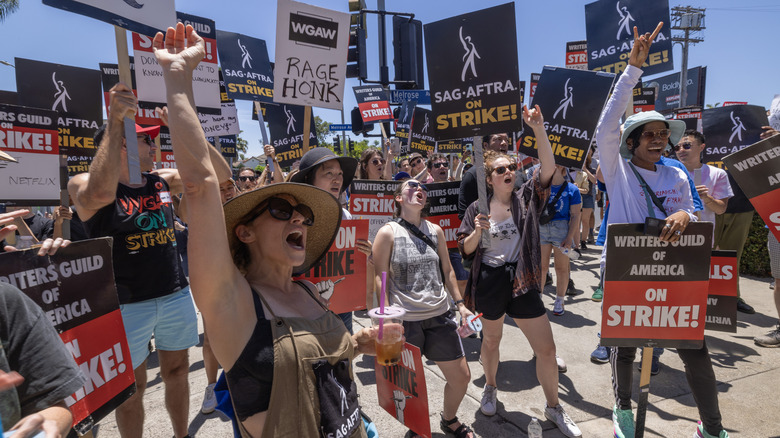The 2023 SAG-AFTRA Strike Explained
The Hollywood labor union representing approximately 160,000 actors and media professionals known as the Screen Actors Guild – American Federation of Television and Radio Artists (SAG-AFTRA) has officially started striking as of July 14, 2023, joining the already 11,500 Writers Guild of America (WGA) members who have been on strike since May 2, 2023. The dual strikes are only the second time in history both unions have come together for an industrywide shutdown — the last time this happened was all the way back in 1960.
The decision to strike was made by a unanimous vote after contract negotiations with the trade association representing Hollywood's major media companies, known as the Alliance of Motion Picture and Television Producers (AMPTP), failed to come to an agreement by the July 12 deadline. Until the labor unions and the AMPTP can come to a consensus, the work stoppage will affect not only the entertainment industry, but the rest of the country will face economic consequences as well. But that's kind of the point. The decision to strike isn't taken lightly by anyone, with the idea being that the pressure will prove the workers' value and inspire fair concessions.
So how exactly will the strike play out, and what does it mean for the state of Hollywood, labor rights, and you, the viewer? Below, we explain everything you need to know about the 2023 SAG-AFTRA strike.
SAG-AFTRA's demands
The SAG-AFTRA union operates on behalf of its members, advocating for the protection of their labor rights including everything from health care to minimum compensation. But as the entertainment landscape changes over the years, so do SAG-AFTRA's needs, which is exactly why contract renewals are scheduled every three years. This year, SAG-AFTRA's main points of contention revolve around streaming and artificial intelligence (AI). Similar to WGA's demands, SAG-AFTRA is asking for increased compensation and streaming residual pay to reflect the value of member contributions, protection against the misuse of AI regarding actors' likenesses, and the regulation of self-taped auditions.
With rising inflation, longer hiatuses between TV seasons, and shorter season orders normalized by streaming services, workers are experiencing a significant pay cut, while corporations benefit by pocketing more money from this formula. Additionally, SAG-AFTRA is seeking to protect members against the threat of rapidly evolving AI that could allow studios to use a performer's likeness to create new performances without additional pay or further consent. Finally, since self-taped auditions have become the standard for studios and casting agencies, performers are burdened with taking on uncompensated additional work — often coming out of pocket for professional equipment and rented-out spaces. SAG-AFTRA is asking to regulate this system with "reasonable rules and limitations, and access to other casting formats," as their strike authorization vote letter reads on their website.
AMPTP's response
Bargaining on behalf of major studios such as Amazon, Apple, Disney, NBC, and Netflix, among others, the AMPTP promptly responded to SAG-AFTRA's decision to strike while SAG-AFTRA leaders were holding their press conference. According to their statement, "The AMPTP presented a deal that offered historic pay and residual increases, substantially higher caps on pension and health contributions, audition protections, shortened series option periods, and a groundbreaking AI proposal that protects actors' digital likenesses for SAG-AFTRA members." However, if these offers were as generous as the AMPTP claim them to be, there never would've been a strike in the first place.
During the press conference, SAG-AFTRA's chief negotiator Director Duncan Crabtree-Ireland corrected the record regarding the AMPTP's "groundbreaking AI proposal," stating the AMPTP is offering one day's pay to background actors who chose to give up their likeness for studios to use whenever, however, and as often as they like — a far cry from protecting actors from AI exploitation.
Studio executives represented by the AMPTP have been speaking openly about their anti-union strategy. "The endgame is to allow things to drag on until union members start losing their apartments and losing their houses," a studio executive told Deadline. During an interview with CNBC's David Faber at the Sun Valley Conference in Idaho, Disney's CEO, Bob Iger, addressed the ongoing strike, blaming the unions for the strike's economic consequences. Meanwhile, Iger is slated to take home approximately $27 million in 2023.
The timeline
Two days before SAG-AFTRA entered negotiations with the AMPTP, members voted to authorize a strike if a deal wasn't reached in time — with an approval rating of 97.91% out of the 47.69% of members who participated. "Together we lock elbows and in unity we build a new contract that honors our contributions in this remarkable industry, reflects the new digital and streaming business model and brings all our concerns for protections and benefits into the now!" SAG-AFTRA president Fran Drescher expressed in response. On June 7, negotiations began, one day after the Directors Guild of America (DGA) approved their own contract with the AMPTP.
As negotiations neared an end, more than 300 actors, including names like Meryl Streep, Jennifer Lawrence, Bob Odenkirk, Quinta Brunson, Amy Poehler, and Ben Stiller, came together to craft a letter to leadership obtained by Rolling Stone indicating that "SAG-AFTRA members may be ready to make sacrifices that leadership is not." The day after the letter became public, it reached more than 1,000 signatures.
On June 30, SAG-AFTRA's contract with the AMPTP was set to expire, and both parties agreed to extend the deadline to July 12 for further negotiations. On July 13, it was announced by SAG-AFTRA that the contract expired on July 12 at 11:59 p.m. PT without a deal. That same day, the decision was made to strike, starting July 14 at midnight.
Hollywood is changing
The entertainment industry is in a constant state of change, from the introduction of "talkies" in the 1920s to home video in the 1980s and, now, streaming. Although the shift to streaming has been on the rise since the 2010s and expedited by the COVID-19 pandemic, industry professionals are still trying to find their footing as they navigate the uncharted territory of this new age of media consumption. In July 2022, Nielsen reported that streaming viewership beat out cable and broadcast TV. That same year, Netflix saw a decline in subscribers for the first time in a decade. Meanwhile, other major streaming services are operating at a loss in an attempt to play catch-up. After throwing all their money at the wall with series orders, platforms are now reversing course, cutting back on spending and issuing massive layoffs.
As awful as these business models are, the stakes are exponentially lower for billionaire investor-backed studios compared to their working-class performers, writers, and other creatives. Despite the losses, studio executives continue to pocket hefty bonuses and pay raises, while actors and writers on strike only wish to receive fair pay and working rights for the value they provide. In addition to fighting for a living wage, industry workers now have to worry about being exploited by new AI technology. Although AI could prove to be a useful, industry-changing tool, the looming threat of job replacement overshadows the benefits without proper regulations put into place.
The impact of previous strikes
That last major actors' strike occurred more than four decades ago, lasting from July 21 to October 23, 1980, over disputes regarding a significant pay increase and residuals for home media. At the time, SAG and AFTRA operated as separate unions negotiating under a joint contract that would eventually lead to their 2012 merger. The three-month-long strike resulted in the industry losing an estimated $40 million a week and a boycott of the 32nd Primetime Emmy Awards. Ultimately, the actors were granted a 32.5% pay rise and a 30% increase in residuals.
Before that, Hollywood experienced its first shutdown when actors and writers went on dual strikes in 1960, similar to what we're experiencing today. Before Ronald Reagan became the leader of the conservative movement in the United States, he was leading the fight for workers' rights as SAG's official president and head negotiator. At this time, actors were striking for their right to residual payments for motion pictures featured on TV.
After six weeks of striking, SAG and the studios came to an agreement on April 18. Actors would receive residuals for all studio films made from 1960 onwards. For films made between 1948 and 1959, there would be a one-time payout of $2.25 million in place of residuals. Writers continued to strike for approximately two more months until they came to their own set of agreements on June 12. There's no doubt the simultaneous strikes helped secure ample deals for both unions. Today, members remain hopeful that the added pressure and total shutdown will work in their favor once again to ensure an agreement sooner rather than later.
Where other Hollywood labor unions stand
The WGA has been on strike since May 2, concerning issues of minimum compensation, residuals, staffing requirements, pension and health plans, and the regulation of AI. The strike has already taken a significant toll on the industry, with dozens of TV shows and movies being postponed or canceled. According to the Motion Picture Association, a major film production being shot on location can contribute $250,000 per day to the local economy. As of July 14, the city and county film permit office, FilmLA, reported that for two consecutive weeks, no scripted productions have been filmed on location in Los Angeles. Further negotiations have yet to be scheduled, but with actors joining the picket lines, that could soon change.
As for the DGA, 87% of their 16,321 eligible voters voted to ratify an agreement for a new contract between the union and the AMPTP that took effect July 1. "Our new contract secures gains on wages, global streaming residuals, safety, diversity and creative rights that build for the future and impact every category of member in our Guild," DGA president Lesli Linka Glatter claimed in a statement. During this time, SAG-AFTRA was still in the midst of negotiations, and although the agreement was a net positive for the industry, Crabtree-Ireland made it clear that the deal would not affect SAG-AFTRA's goals. The WGA took the same position.
TV shows and movies impacted by the strike
We've covered how the industry is being affected by the double strike, but what about the consumer? A common sentiment held in the age of streaming is that there's an overwhelming amount of entertainment to choose from, but the longer the strike continues, the sooner audiences might have to start scraping the bottom of the barrel. According to HBO chairman Casey Bloys, a notable lack of new scripted content will likely become apparent by mid-2024. Many anticipated movies with 2024 release dates were in the midst of production when the SAG-AFTRA strike began, including "Beetlejuice 2," "Deadpool 3," "Gladiator 2," and many others. Depending on when actors can return to work, release dates for these projects will likely be pushed back. As for TV, we've already seen late-night talk shows go dark, and many scripted shows have halted any further production for upcoming seasons in response to the writers' strike, including "Abbott Elementary," "Big Mouth," "Cobra Kai," "Stranger Things," and others.
Essentially, the only movies and TV shows that won't face a direct impact from the strike are projects already in post-production and unscripted programming. As evident by past strikes, unscripted series and reruns will make up the majority of network programming. Award season will also be heavily disrupted, with the postponement of the 75th annual Emmy Awards and the uncertainty surrounding fall film festivals.
Industry solidarity
Following the SAG-AFTRA strike announcement, actors, writers, and other industry professionals wasted no time expressing support and solidarity for the cause. Leading up to the strike, the "Oppenheimer" London premiere was pushed up one hour to allow time for stars to walk the carpet. The cast promptly left the event before the movie began in solidarity with their fellow actors. "We got to protect the people who are kind of on the margins. Twenty-six thousand bucks a year is what you have to make to get your health insurance. And there are a lot of people who ― residual payments are what carry them across that threshold. If those residual payments dry up, so does their healthcare, and that's absolutely unacceptable," Damon told the Associated Press during the event.
The "Oppenheimer" cast members are far from the only A-list actors who have used their status to show support. While walking her final red carpet before the strike for "Barbie," Margot Robbie shared her support for all the unions when asked about the strike. Taking to social media, Keke Palmer, Jessica Chastain, John Cusack, Mark Ruffalo, Patton Oswalt, Jamie Lee Curtis, and others have used their platforms to advocate for fellow striking workers. "I am one of the very, very lucky and rare actors that has a strong position to negotiate from when I work. That is not the experience of most people, and I do think both the actors and writers who are currently striking, nobody wants these things to happen — but I think they're incredibly necessary for the way the industry is going," Daniel Radcliffe told Vanity Fair.
Striking Dos and Don'ts
As soon as SAG-AFTRA's contract with the AMPTP expired and the strike was initiated, all members covered by the TV/Theatrical Contracts were required to cease services immediately. This includes principal on and off-camera work, background work, stand-in work, photo and/or body doubles, fittings, wardrobe, and makeup tests, scanning, interviews and auditions, promotional work, contract negotiations, and performing for a struck production. Members are also required not to cross picket lines and inform the union of any strikebreaking activity. Non-members who wish to one day be admitted into the union must also follow the picket line rules or risk being barred from admission.
However, there are exceptions for members — outlined by Vanity Fair — looking to work outside of theatrical and TV work, including commercials, music videos, corporate/educational videos, news broadcasts, morning shows, talk shows, network soap operas, variety shows, reality shows, game shows, and sports programs, all of which are covered under a separate contract. Independent podcasts and audiobooks are permitted as well.
What's next?
There's no way to know how long the strike will last or when negotiations will resume. Really, it's up to the AMPTP, but based on what's been reported, both parties are seemingly in for the long haul. The last WGA strike in 2007 cost California an estimated $2.1 billion. With both SAG-AFTRA and WGA striking, leaving hundreds of thousands out of work, experts fear a significantly larger economic fallout that'll extend to local businesses and even the housing market. "The economy is slowing and contracting," Sanjay Sharma, an adjunct professor at USC's Marshall School of Business, told The Los Angeles Times. "Everything is getting more expensive every day. Interest rates are rising." If the strike lasts long enough, big studios may try to use the loss to their advantage by blaming their pre-planned project cancelations and layoffs on the unions.
In the end, the goal is for short-term suffering to lead to long-term gains for current and future workers. Even if you have gripes with the quality of content Hollywood puts out, supporting the few remaining powerful unions in the country is in the best interest of the entirety of the working class. The best way to support performers and writers out of work is to take to social media or donate directly to union funds that provide critical relief to members in need. On their websites, SAG-AFTRA uses an Emergency Financial Assistance and Disaster Relief Fund, while WGA uses Good and Welfare Emergency Assistance Loans.










